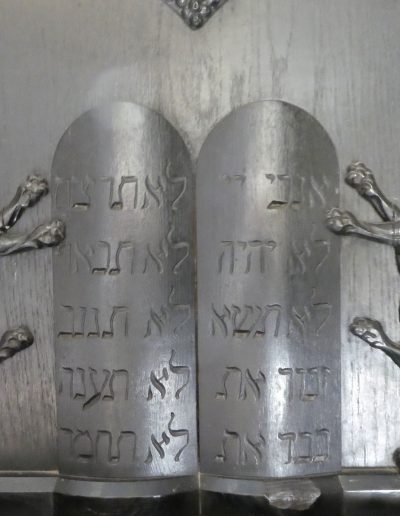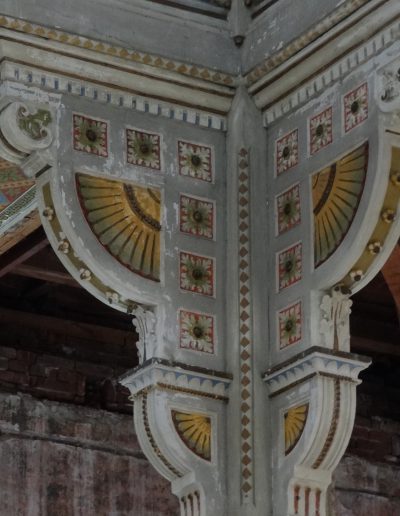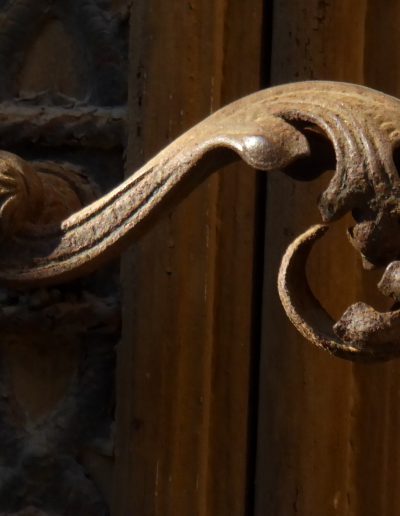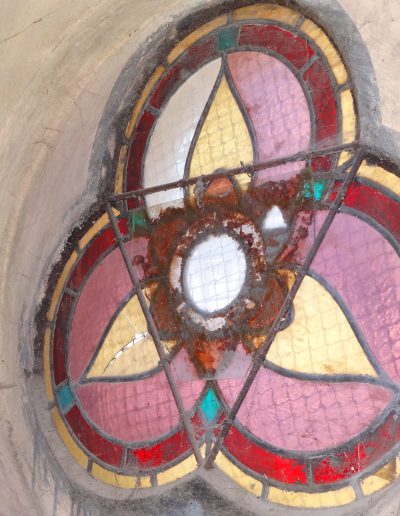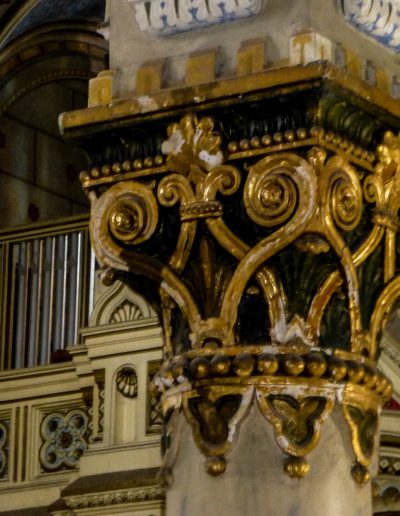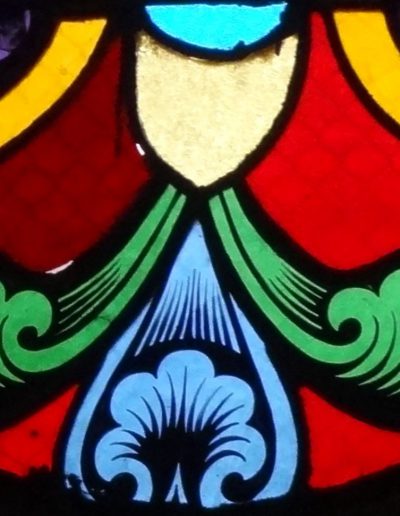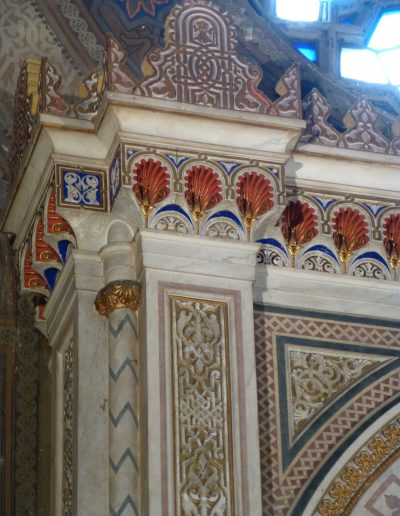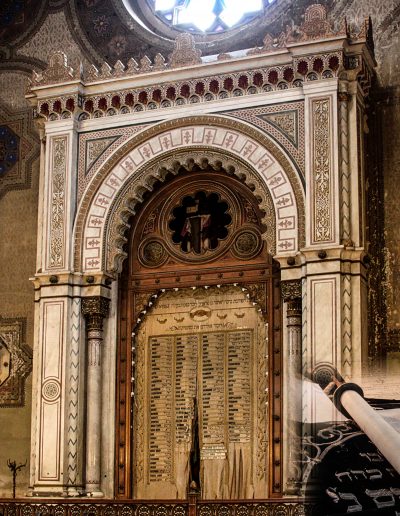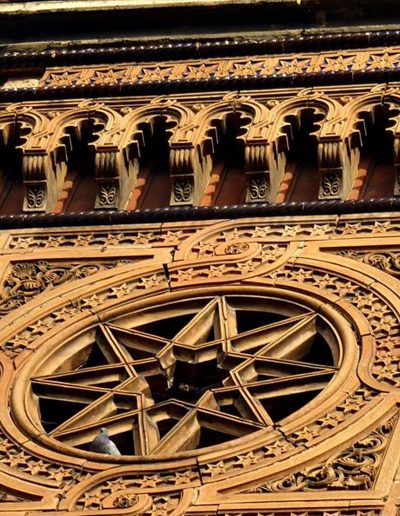The Hebrew terms used for the Jewish place of worship express its triple meaning as a place of prayer, assembly, and teaching: Bet Tefila ("house of prayer"), Bet Kneset ("house of assembly"), Beth Hamidras ("house of teaching"). In Romanian, the current language uses synagogue (from Greek, "assembly"), temple (a term used by neologism or liberal Jews), shil or shul (Yiddish, from Schule, "school" in German).
Synagogues are built facing Jerusalem, ie east in western and central Europe. The congregation faces the east wall, where the ark is (Aron Kodeş, "the holy closet"). Behind a richly embroidered curtain (parochet), here are kept the scrolls of the Torah, the 5 books of Moses, Sefer Torah or Pentateuch, the word of Greek origin, protected with velvet covers or shiny material with gold or silver embroidery and crowned with a crown, often with bells, usually of hammered and chiseled silver. Above the ark are the tablets of the law with the Ten Commandments, and in front constantly burns an "eternal light" (Ner tamid) that symbolizes the presence of God and reminds of the fire that was constantly burning on the altar of sacrifices in front of the temple in Jerusalem. Next to the ark is sometimes a menorah, a seven-armed candlestick, the main symbol of Judaism and the national coat of arms of the State of Israel. On a platform (bima or, in Arabic, almemar) is a desk on which the Torah scroll unfolds from which a portion is read, so that during a year the entire Pentateuch is traversed. To the right and left of the ark are the seats for the rabbi, the religious leader of the community, hazan (singer) and gabai (the person overseeing the divine office). A condition of religious service is the gathering of a Minian, ten men. A boy becomes Bar Mitzvah, a major member of the community, at the age of 13. In reformist communities, women participate in religious service equally with men.
In the three large synagogues in Timisoara, the meeting room on the ground floor is reserved for men, and the seats for women are located upstairs, where access is via the stairs leading from the side gates of the synagogue to the upper level. The view of the opposite sex could divert thoughts from prayer and spirituality, Orthodox Jews believe, so in the Orthodox synagogue in Josephine, visibility to and from the gallery is reduced by bars. Nowadays, the number of community members has decreased a lot, permissiveness has increased, so that women and men are together on the ground floor during the service. Men carries a yarnmulke (a cap), and married women were covered with a head scarf or a hat.
Is there a specific architectural style for synagogues? There are no normative recommendations, this explains the motley architectural aspect over time and in different parts of the world. In ancient times it was built under Egyptian or Assyrian influence. Later, Greek culture made its mark, in the Middle Ages it was built in the Gothic style, in Italy, in the style of the Italian Renaissance, and in the Netherlands, in the manner of Dutch buildings. In China or Japan, synagogues are indistinguishable in the urban landscape. Builders adapted to the local style at the time, erecting generally modest buildings that were not meant to stand out, complying with the requirements and often discriminatory restrictions imposed by the local administration.
The synagogues in Timisoara
The existing Timişoara synagogue buildings - the Neolog Synagogue in Citadel (1865), the two Orthodox synagogues in Josephine and Fabric (both inaugurated in 1895) and the New Status quo ante Synagogue in Fabric (1899) - reflect the artistic currents of that era. In Central and Eastern Europe, the Moorish style, also called Mudejar art, was adopted during this period, with elements of Islamic art. For Jews in the second half of the nineteenth century, the elements perceived as exotic corresponded to the desire to differentiate themselves from church architecture and to assert their community identity. At that moment of emancipation and reform of the religious practice in Judaism, the pride of the Semitic and Jewish affiliation found its expression in imposing constructions, clearly distinct from the surrounding architectural landscape. In addition, the precious arabesques awakened in memory of the Sephardic Jews (Spaniards) the mythical "golden age" of the Middle Ages, spent in the Iberian Peninsula under Muslim rule. In the architecture of the Timişoara synagogues we will discover features from the Arab-Muslim art, although it had nothing in common with Judaism.
Although the impression of Moorish art predominates, the style is eclectic, incorporating classicist, neo-renaissance, gothic or secession elements, as well as church-specific motifs, such as stained glass and rosettes on the facades. Among the structural elements of Islamic art we find horseshoe-shaped vaults, arches and crenellated cornices, towers that evoke the silhouette of minarets. Brick is used as a building material, in combination with stone, sometimes in horizontal strips, of two colors, red and yellow. Polychrome ceramic decorations, arabesques with floral motifs or geometric shapes, exuberant colors radiate vitality and optimism.
The neolog synagogue of the Citadel (1865), the orthodox synagogues of Josephine and Fabric (both inaugurated in 1895) and the New Status quo ante Synagogue of Fabric (1899) reflect the artistic currents of the late nineteenth century. In Central and Eastern Europe, the Moorish style, also called Mudejar, with elements of Islamic art was adopted during this period. In the architecture of the Timişoara synagogues we will discover features of Arab-Muslim art, although it had nothing in common with Judaism, but also classicist, neo-renaissance, Gothic or Secession elements, as well as church-specific motifs, such as stained glass. and rosettes on the facades.
Source: In the footsteps of the Jewish Timisoara. More than a guide. By Getta Neumann. Brumar Publishing House, 2019


